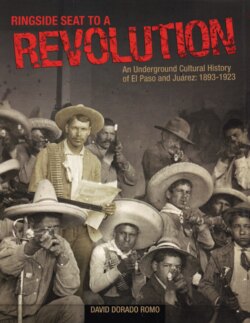Читать книгу Ringside Seat to a Revolution - David Dorado Romo - Страница 59
На сайте Литреса книга снята с продажи.
ОглавлениеEmma Goldman spoke in El Paso on March 12, 1910.
(El Paso Times, 1910.)
anarchist individuals and organizations. They met
with members of the IWW, with Spanish anarchist
Florencio Bazora and with Jewish-American agitator
Emma Goldman—whom the El Paso Times mocked as
“the Queen of the Anarchists” during her visit to the
city in 1910.
54
Ricardo found inspiration in his own country for
anarchism as well. The concept of communal owner-
ship of property without the need for centralized
authority had been a natural way of life among the
indigenous communities of Mexico for thousands of
years. But to a large extent, his anarchism grew grad-
ually from his own direct experiences and political
reflections.
Experience taught him that governments, no mat-
ter what they called themselves, could be equally
repressive. In Mexico, the Magonistas were persecut-
ed and imprisoned for their writings by a government
run by a dictator. In the United States, they faced sim-
ilar persecution at the hands of a government that
called itself a liberal democracy. After the Magón
brothers went into exile in 1904, American govern-
ment agents and private detectives hired by the
Mexican government hounded them and their collab-
orators wherever they went. It didn’t matter where
the Magonistas tried to hide—Laredo, San Antonio,
Los Angeles, San Francisco, Sacramento, Toronto,
Montreal, El Paso—the agents always found them.
The United States Postal Service, for years, opened
their mail and handed it over to the Mexican govern-
ment. The Mexican radicals were constantly in and
out of American jails on the charges of libel, sedition
and neutrality law violations.
After years of organizing, writing and meditating
on history, Ricardo Flores Magón came to the conclu-
sion that all forms of centralized government should
be abolished. He predicted that any revolution in
Mexico that only aimed to replace one centralized
government with another—whether run by a presi-
dent or a revolutionary junta—was bound to end in
failure. “The same thing has always happened, every-
where,” Ricardo wrote in 1908:
A flag is raised with calls for more or less
important reforms; the poor follow their
lead; they struggle; blood is spilled more or
less abundantly and if the revolution tri-
umphs, a congress is formed to put into law
the ideals that pushed the masses to take up
arms and fight. The congress is attended by
individuals with all kinds of ideas, some
advanced, others reactionary, most others
moderate, and during the struggle between
all of these tendencies the aims of the revo-
lution wither, lose their vitality and after
many months or years, laws are approved
that don’t even slightly resemble the ideals
so many gave their lives for.121
Even if “by a miracle” some of those ideals that
inspired the revolution are decreed as law, Magón
explained, the rich inevitably rebel against such a
program and “the people, without bread, listen to the
bourgeoisie tell them they must compromise.” The
results are a new government little different from the
last. Only an anarchist revolution, Magón argued,
governed from the bottom up by a loose federation
of autonomous worker and campesino communities
could prevent this from happening once more.
And where would be a good place to launch
such a revolution from?
Why, El Paso, of course.
121
Ricardo Flores Magón to Enrique Flores Magón and Práxedis Guerrero, June 13, 1908. Correspondencia, p. 379-380.
